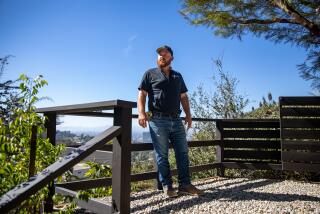Contractor Isn’t Qualified as Chimney Sweep
- Share via
QUESTION: My home in Pacific Palisades was recently inspected by a home inspector, who reported a safety problem with my chimney--something to do with the outer metal wall venting inside the attic. I asked my plumbing and heating contractor to check the chimney, and he found it to be OK. I called the home inspector and asked him to please correct his report, but he insisted that I hire a chimney sweep.
I’m confident in my contractor’s qualifications, but the people who are buying my home insist on following the home inspector’s advice. This seems like a needless expense. What is your advice?
ANSWER: I’m amazed that people will consult contractors in matters not within the scope of their professional expertise. I’ve known qualified plumbers and competent heating contractors, but none who installs or repairs fireplaces or chimneys.
What surprises me further is that any contractor would venture opinions relating to fireplace safety, especially when you consider the inherent liability in such representations.
The chimney sweep profession is among the most taken-for-granted of all building-related trades. People tend to think of sweeps as mere cleaning crews with top hats, long-tail coats and sooty faces. With all due respect to “Mary Poppins,” this is an unfortunate misrepresentation that sadly demeans a highly specialized profession.
A qualified chimney sweep is a knowledgeable technician, possessing an array of skills essential to the construction, installation, and repair of all types of wood-burning fixtures and equipment. A sweep’s overall knowledge is unique, encompassing fire-safety standards beyond the sphere of other building trades.
In addition to specific hands-on skills, a chimney sweep is proficient in legal requirements set forth by the National Fire Code and is familiar with safety specifications affecting all types of fireplaces, inserts and wood-burning stoves.
The chimney condition in your attic, as reported by the home inspector, is not a matter to be evaluated or dismissed by just anyone. Faulty diagnosis and failure to make needed repairs could result in a major roof fire for you or for your buyer.
Most metal chimneys consist of two sheet metal shafts, one contained within the other. The purpose of a double-wall chimney is to prevent the outer surface from becoming hot enough to start a fire in your attic.
The air between the two chimney walls can be extremely hot and therefore must vent into the open air above your roof. When the top of the outer chimney wall terminates inside the attic, heated air can scorch the wood framing to the point of combustion.
The bottom line in matters of fire safety is to consult the appropriate expert.
A proper evaluation could save your home and possibly someone’s life.
Cable Guy’s Right About Dryer Duct
Q: The exhaust pipe from our clothes dryer extends through a hole in the floor. It’s been working that way for nearly eight years and has caused no problem that I’m aware of.
Last week the cable man was under the house and said we should extend the dryer duct to the outside of the building, rather than letting it blow under the building. What difference does it make?
A: Your cable installer deserves a hearty thank-you. There are three reasons not to vent a clothes dryer into a crawl space:
All of the water from your wet laundry is being blown into the subfloor area in the form of steam. During cold weather, this vapor may condense on the wood framing, where it can cause fungus damage to the structure.
The accumulation of laundry lint in the crawl space creates a fire hazard. Venting a dryer to the sub-area is forbidden by code, precisely for the two previous reasons.
I recommend that you hire a licensed plumber to install a sheet metal duct to convey the dryer exhaust to the exterior of your home.
Roof Leakage Unlikely to Cause Dry-Rot
Q: The home we’re buying has just had major repair work on the roof. But past leakage has left large water stains on the ceilings, and these have us worried about possible wood rot in the attic.
We’ve asked that the ceilings be opened for further inspection by our home inspector, but the owner refuses to have this done, insisting that wood rot is unlikely. We feel that something should be done to guarantee the condition of the structure. Does this kind of follow-up seem reasonable to you?
A: Dry-rot typically occurs when wood components remain wet for extended periods of time, such as when soil is in direct contact with wood or where ongoing plumbing leaks expose wood members to continuous moisture. With roof leakage, however, rotted attic framing is highly unusual.
Attic spaces are typically warm and dry most of the year. Even during winter weather, intermittent sunny days can warm an attic, allowing the water from recent roof leakage to dry quickly. On colder days, the heating system within the dwelling provides warmth that can also promote evaporation of moisture in the roof and ceiling framing.
If the attic structure is rotted in the home you’re buying, the termite inspector would most likely have discovered it when he crawled through the attic. And this certainly would not require opening the ceilings.
*
Got a question about home inspection? Send it to Barry Stone, Los Angeles Times, 540 Atascadero Road, Morro Bay, CA 93442.
More to Read
Inside the business of entertainment
The Wide Shot brings you news, analysis and insights on everything from streaming wars to production — and what it all means for the future.
You may occasionally receive promotional content from the Los Angeles Times.










